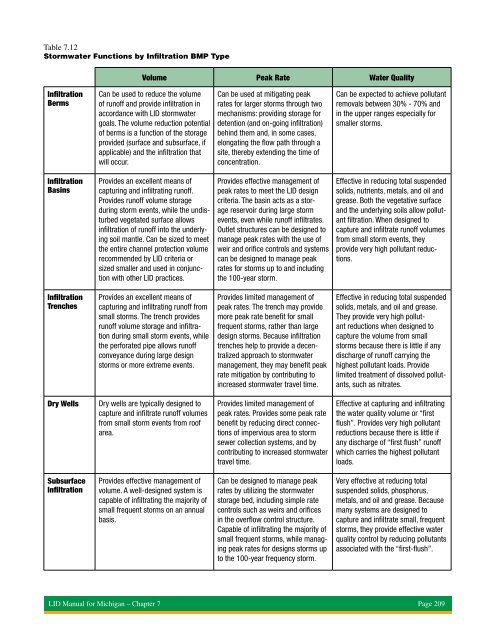Low Impact Development Manual for Michigan - OSEH - University ...
Low Impact Development Manual for Michigan - OSEH - University ...
Low Impact Development Manual for Michigan - OSEH - University ...
You also want an ePaper? Increase the reach of your titles
YUMPU automatically turns print PDFs into web optimized ePapers that Google loves.
Table 7.12<br />
Stormwater Functions by Infiltration BMP Type<br />
Infiltration<br />
Berms<br />
Infiltration<br />
Basins<br />
Infiltration<br />
Trenches<br />
Volume Peak Rate Water Quality<br />
Can be used to reduce the volume<br />
of runoff and provide infiltration in<br />
accordance with LID stormwater<br />
goals. The volume reduction potential<br />
of berms is a function of the storage<br />
provided (surface and subsurface, if<br />
applicable) and the infiltration that<br />
will occur.<br />
Provides an excellent means of<br />
capturing and infiltrating runoff.<br />
Provides runoff volume storage<br />
during storm events, while the undisturbed<br />
vegetated surface allows<br />
infiltration of runoff into the underlying<br />
soil mantle. Can be sized to meet<br />
the entire channel protection volume<br />
recommended by LID criteria or<br />
sized smaller and used in conjunction<br />
with other LID practices.<br />
Provides an excellent means of<br />
capturing and infiltrating runoff from<br />
small storms. The trench provides<br />
runoff volume storage and infiltration<br />
during small storm events, while<br />
the per<strong>for</strong>ated pipe allows runoff<br />
conveyance during large design<br />
storms or more extreme events.<br />
Dry Wells Dry wells are typically designed to<br />
capture and infiltrate runoff volumes<br />
from small storm events from roof<br />
area.<br />
Subsurface<br />
Infiltration<br />
Provides effective management of<br />
volume. A well-designed system is<br />
capable of infiltrating the majority of<br />
small frequent storms on an annual<br />
basis.<br />
Can be used at mitigating peak<br />
rates <strong>for</strong> larger storms through two<br />
mechanisms: providing storage <strong>for</strong><br />
detention (and on-going infiltration)<br />
behind them and, in some cases,<br />
elongating the flow path through a<br />
site, thereby extending the time of<br />
concentration.<br />
Provides effective management of<br />
peak rates to meet the LID design<br />
criteria. The basin acts as a storage<br />
reservoir during large storm<br />
events, even while runoff infiltrates.<br />
Outlet structures can be designed to<br />
manage peak rates with the use of<br />
weir and orifice controls and systems<br />
can be designed to manage peak<br />
rates <strong>for</strong> storms up to and including<br />
the 100-year storm.<br />
Provides limited management of<br />
peak rates. The trench may provide<br />
more peak rate benefit <strong>for</strong> small<br />
frequent storms, rather than large<br />
design storms. Because infiltration<br />
trenches help to provide a decentralized<br />
approach to stormwater<br />
management, they may benefit peak<br />
rate mitigation by contributing to<br />
increased stormwater travel time.<br />
Provides limited management of<br />
peak rates. Provides some peak rate<br />
benefit by reducing direct connections<br />
of impervious area to storm<br />
sewer collection systems, and by<br />
contributing to increased stormwater<br />
travel time.<br />
Can be designed to manage peak<br />
rates by utilizing the stormwater<br />
storage bed, including simple rate<br />
controls such as weirs and orifices<br />
in the overflow control structure.<br />
Capable of infiltrating the majority of<br />
small frequent storms, while managing<br />
peak rates <strong>for</strong> designs storms up<br />
to the 100-year frequency storm.<br />
Can be expected to achieve pollutant<br />
removals between 30% - 70% and<br />
in the upper ranges especially <strong>for</strong><br />
smaller storms.<br />
Effective in reducing total suspended<br />
solids, nutrients, metals, and oil and<br />
grease. Both the vegetative surface<br />
and the underlying soils allow pollutant<br />
filtration. When designed to<br />
capture and infiltrate runoff volumes<br />
from small storm events, they<br />
provide very high pollutant reductions.<br />
Effective in reducing total suspended<br />
solids, metals, and oil and grease.<br />
They provide very high pollutant<br />
reductions when designed to<br />
capture the volume from small<br />
storms because there is little if any<br />
discharge of runoff carrying the<br />
highest pollutant loads. Provide<br />
limited treatment of dissolved pollutants,<br />
such as nitrates.<br />
Effective at capturing and infiltrating<br />
the water quality volume or “first<br />
flush”. Provides very high pollutant<br />
reductions because there is little if<br />
any discharge of “first flush” runoff<br />
which carries the highest pollutant<br />
loads.<br />
Very effective at reducing total<br />
suspended solids, phosphorus,<br />
metals, and oil and grease. Because<br />
many systems are designed to<br />
capture and infiltrate small, frequent<br />
storms, they provide effective water<br />
quality control by reducing pollutants<br />
associated with the “first-flush”.<br />
LID <strong>Manual</strong> <strong>for</strong> <strong>Michigan</strong> – Chapter 7 Page 209

















